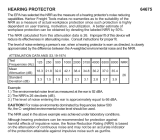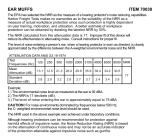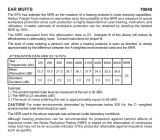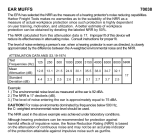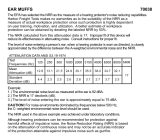Page is loading ...

WorkTunes
™
Hearing Protector
User Instructions
Noise Reduction Rating (NRR)
The EPA (Environmental Protection Agency) has selected the NRR
(Noise Reduction Rating) as the measure of a hearing protector’s
noise-reducing capabilities. 3M makes no warranties as the suitability of
NRR as a measure of actual protection from any noise level since such
protection depends on the sound level (loudness), how long you listen
to the loud sound, and how well you fit the earmuff over your ears.
Although hearing protectors can be recommended for protection against
harmful effects of impulsive noise, the Noise Reduction Rating (NRR) is
based on the attenuation of continuous noise and may not be an
accurate indicator of the protection attainable against impulse noises
such as gunfire.
Research suggests that many users will receive less noise reduction
than indicated by the NRR due to variation in earmuff fit and wearing
time. 3M recommends reducing the NRR by 50% for estimating the
average amount of noise reduction provided.
The NRR for Worktunes
™
Hearing Protector is 24 dB. Improper fit of this
device will reduce its effectiveness in attenuating noise. Consult the
enclosed instructions for proper fit.
The level of noise entering a person’s ear when a hearing protector is
worn as directed is closely approximated by the difference between the
A-weighted environmental noise level and the NRR.
Attenuation (ANSI S3.19 – 1974)
Test Frequencies in (Hz) 125 250 500 1000 2000 3150 4000 6300 8000 NRR
Mean Attenuation (dB) 16.0 21.4 25.7 35.7 32.0 39.9 40.7 36.0 34.0
24
Standard Deviation (dB) 3.5 3.5 2.4 3.7 3.0 3.0 3.3 4.4 6.1
Example
1. The environmental noise level as measured at the ear is 92 dB.
2. The NRR is 24 decibels (dB).
3. The level of noise entering the ear is approximately equal to 68 dB.
Caution
For noisy environments dominated by frequencies below 500 Hz, the
C-weighted environmental noise level should be used. The NRR used in
the above example was achieved under laboratory conditions.
WARNING!
These hearing protectors help reduce exposure to hazardous noise and
other loud sounds. Misuse or failure to wear hearing protectors at all
times that you are exposed to noise may result in hearing loss or injury. If
there is any drainage from your ear or if you have a hole in your eardrum,
consult with your physician before wearing hearing protection. Failure to
do so may result in hearing loss or injury. For proper use, see user
instructions or call 3M Technical Service toll free at 1-800-494-3552.
For more information
About this product, and all 3M Safety Products, visit 3Msafety.com
For technical assistance please call 1-800-494-3552
3M and WorkTunes are trademarks of 3M.
© 3M 2014 All rights reserved. 34-8714-5090-3
3Msafety.com
Intended Use
When worn properly, WorkTunes
™
Hearing Protectors help reduce
exposure to loud sounds produced during recreational activities, such
as concerts, snowmobiling, or sporting events, and when using power
tools and equipment such as drills, hand sanders, lawn mowers,
garden tractors, and gas-powered leaf blowers/trimmers. For very loud
sounds, such as chain saws, circular saws, hammer drills, jack
hammers, fireworks and gunfire, 3M recommends wearing earmuffs
and earplugs at the same time for additional noise reduction. If you are
wearing hearing protectors for noise outside of work, have your hearing
tested by an audiologist, physician, or other qualified professional on a
regular basis. Hearing protectors should be worn at all times in noisy
surroundings to assist with noise reduction.
Fitting Instructions
Improper fit of this device will reduce its effectiveness. Fit your earmuff
before entering a hazardous noise area.
• Place the earmuff on the head with the band at the crown (top) of
the head
• Pull out the cups and place the hearing protector over your ears so
that the ear cushions fit snugly
• It is important that the cups fully enclose the ears and that the
cushions exert equal pressure around the ears
• Adjust the height of both cups for comfort and a good seal – do this
by sliding the cup up or down while holding the headband in place
• Do not store the hearing protector at temperatures above 131°F or
55°C (for example, behind a windshield or in a window)
Important: For proper fit, ear cushions should seal firmly against the
head. Anything that interferes with the seal such as long hair (pull back
to the extent possible), thick or poorly fitting eyeglass temples, pencils
or caps will lessen the earmuff’s effectiveness
Do not bend and reshape the headband, as this will cause a loose fit
and sound leakage.
Care and Cleaning
WorkTunes
™
Hearing Protector may be disassembled for cleaning.
Sponge clean with warm soapy water, and rinse thoroughly. Do not
use solvents. Let the foam liner dry before re-inserting into ear cups.
Earmuffs must be regularly inspected for cracked or worn parts, and
replaced as needed. Typical life for foam cushions is six months. For
assistance please call 1-800-494-3552.
Output Sound Pressure
The Sound Pressure Level (SPL) of the WorkTunes Hearing Protector is
limited to 82dB using ordinary music material when connected to a
Personal Music Player (PMP). If the WorkTunes Hearing Protector are
connected to a PMP or other device with a very high output level, it is the
users responsibility to set the Sound Pressure Level to a safe level.
The electrical input level for which the mean plus one standard deviation
A-weighted diffuse-field related to sound pressure level for the sixteen
ears is equal to 82 dBA is 83 mV.
/
